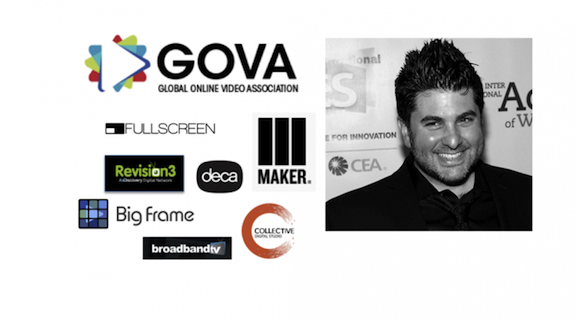Paul Kontonis has been a pioneer in the digital space since helping create one of the earliest official movie websites, for “Batman Forever,” in 1995. He has chaired the International Academy of Web Television, launched a data and analytics platform called OpenSlate, and now has positions with “about six companies” active in online video, including SVP of strategy and sales for Collective Digital Studio.
In short, Kontonis was a strong choice to be named executive director of the recently announced Global Online Video Association (GOVA), an “industry-funded non-profit corporation established to advocate and support the advertising, licensing, production, distribution and overall business interests of its member companies and accelerate growth in the online video industry.” Or, simply put, to help better monetize the wares of founding members such as Big Frame, Discovery Digital Networks/Revision3, Maker Studios, and other major online video players representing more than 10 billion monthly views.
Brief tracked Kontonis down somewhere between his numerous obligations to talk about where online video is headed, where it’s been, and why it’s hard to measure .
BRIEF: What kind of companies are joining GOVA?
Paul Kontonis: You have to be a producer and a distributor of original video content and you also must own and operate a YouTube multi-channel network. So somebody like Discovery with Revision3 and TestTube would fit in perfectly. The cable networks, if they don’t have a YouTube multi-channel network, don’t qualify. And there’s a membership fee. It’s $10,000 a year to become a member.
What are the benefits of paying up?
Honestly, it’s being at the table right now. This is a table we’ll be sitting down at with YouTube to discuss everything from what technology is being rolled out to what their revenue share looks like, what their marketing plans are, etc. This is a group that’s going to be sitting down with the [Interactive Advertising Bureau] to discuss standards of measurement in our space. This is the group that’s sitting down with all the major talent agencies, or even [the Screen Actors Guild] (SAG) to say, “You know, the current structure doesn’t work.”
Are you referring to the current structure of paying SAG performers who appear in online videos?
A lot of the YouTubers, when they first start, are not SAG. They’re just doing it for the fun of it. They start making some money, they start doing really well, they get cast in a commercial, a TV show or a big web series. They get all excited, they join SAG. They’re now members, so they go back to their YouTube channel, turn on their web cam, start shooting, upload it, and then SAG hits them with a fine, because they’re not allowed to do that. It’s not a SAG production.
How might a GOVA member benefit by being privy to direct discussions with YouTube about its developing technologies?
Last August, YouTube rolled out their Superfan tool, which says, “If you have more than 5000 subscribes, through YouTube analytics we’ll tell you who your top viewers are and what their channels are, etc.” No one knew that YouTube was rolling out this tool and almost all the big [multi-channel networks] spent the better half of 2013 building their own tool to do exactly like that. And then we all found out YouTube was rolling it out anyway. We all could haves saved a shitload of development dollars and time if we’d just known they were doing that.
How hard is it to make money in online video?
The biggest factor is, what is your main platform? If your main platform is YouTube, then you have to do it with a low-cost production to make it work. You can’t do TV-related budgets. But what we’re seeing is, if you are on a different platform – a non-YouTube platform – where you control the monetization at a much healthier rate, and you can sell that inventory, you can spend $500,000, [$750,000], $1.5 million to do a series and be profitable between the free ad-based delivery of it and the international licensing deals. You have to do a combination of a multi-window road of distribution or otherwise it won’t work.
One goal of GOVA is exploring measurement standards. What is wrong with the current system?
There are a ridiculous amount of tools available for measuring digital content. The problem is, there are different providers, different metrics, different components to it. I mean, how do you factor in the audience for a show on YouTube when it’s not hitting all at once? We can measure it, but do you combine it? Do you keep it separate? Is it better just to talk about views? Is it better to talk about shares of those videos or how much of those videos were watched? When you can check what percentage of a video was actually watched, do you count a view of 10% of the video equal to a 100% view of the video?
We have all this information, and what you’ll find in the digital space is everyone will say they are number one. Every one will say they are the leader. They’re the number one ranked this, the number one ranked that. Because one day you show comScore data because it favored you, one day you show Nielsen data, one day you show YouTube data… you can pull from all these different sources, and you can slice and dice your data so many different way. There’s no one set way to look at it.
We need to figure out what really makes the most sense and what should we all be talking about. Then you’ll have the ad agencies and the brands and the networks and the distributors all speaking the same language.
Tags:













































__twocolumncontent.jpg)











